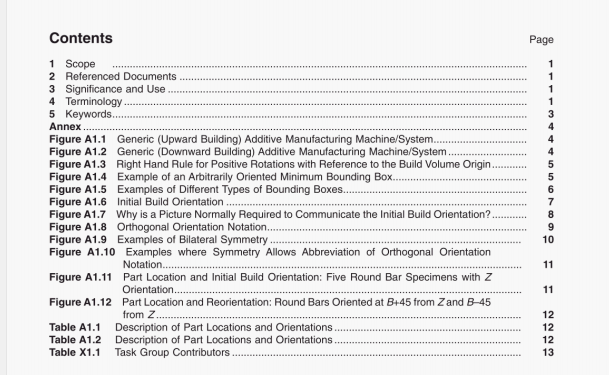AS ISO ASTM 52921:20 pdf download.Standard terminology for additive manufacturing – – Coordinate systems and test methodologies.
its orientation may he described by listing which axis is parallel to the longest overall dimension of the hounding box first, followed by the axis which is parallel to the second longest overall dimension of the hounding box second, followed by the axis which is parallel to the third longest overall dimension of the hounding box.
DiscussioN— For example. a specimen which is placed so that its longest dimension is parallel to the Z axis, the second longest dimension is parallel to the X axis, and its shortest overall dimension is parallel to the Y axis shall be defined as having a ZXY orientation (see A I .8 and A I . 10 for examples).
DiscussioN—Where symmetry allows unambiguous designation of orientation by listing fewer than three axes (in descending order of length). orthogonal orientation notation can he further abbreviated (see Al.9 and Al.lO).
DISc ‘ussioN—Soilw combinations of part symmetry in an orthogonal initial build orientation fully define only one possible orientation and thereibre no image is required to communicate the initial build orientation. This is the case for parts like the dog bone specimen (D638 or Iso 527) in Al.l0, which are bilaterally symmetrical (see Al.9) through its geometric center in the XY, XZ, YZ planes and have no rotational symmetry. This is also the case for parts like the round tension bar (see A 1.10) which have 360° rotational symmetry through a center axis and are also bilaterally symmetrical across the plane bisecting the part perpendicular to the axis of rotational symmetry. Normally, an image is required to identify initial build orientation when parts have features with less than 360° rotational symmetry (see A I .7),
part location, n—within the build volume should be specified by the X, Y, and Z coordinates for the position of the geometric center of each part’s arbitrarily oriented minimum hounding box with respect to the build volume origin (see Al.lI and Al.12).
t)isct IssloN—Where lindi ng the arbitrarily oriented minimum hounding box is not possible or practical. the coordinates of the center of the part’s hounding box (aligned orthogonally to the build volume origin) when the part is in its initial build orientation iiiay he used for defining part location.
part reorientation, u—the reorientation of parts within the build volume shall he specified by rotation around the geometric center of the part’s arbitrarily oriented minimum hounding box in the sequence of A, B, and C (see A I .3 and A I . I 2) from a specified initial build orientation of that part.
DiscussioN—Only non-iero angles need to he listed. For example, see A 1. 12 where the front row of parts are reoriented to A= 0, 8= +45, C= () from an initial build orientation Z and are identified as 8+45 from z.
5. Keywords
5. 1 additive manufacturing; test methods; machine coor nate system; part location; part Orientation.
AS ISO ASTM 52921:20 pdf download
